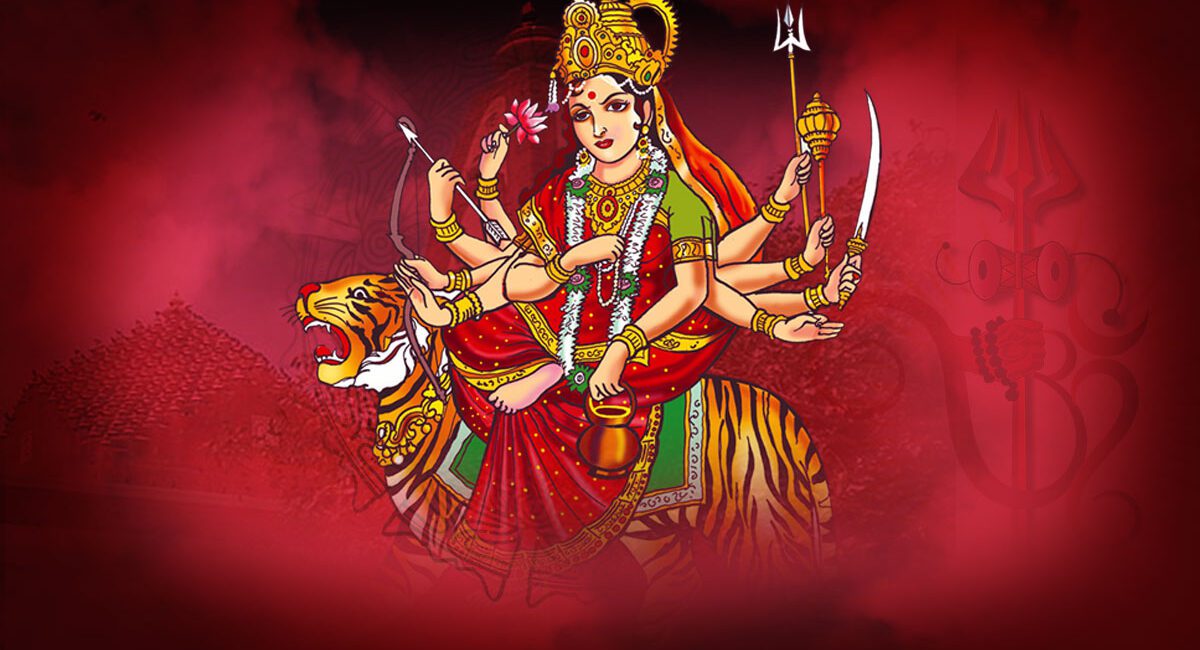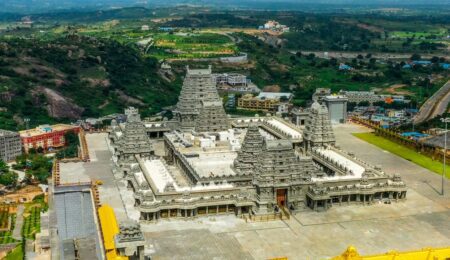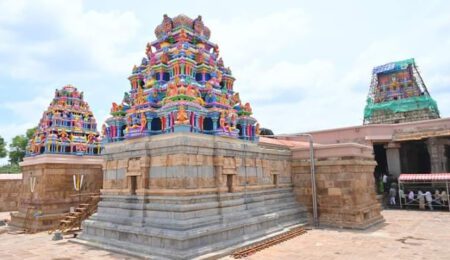Chandraghanta: Meaning, story, mantras, puja vidhi, and Navratri significance
Chandraghanta is the third radiant form of Goddess Durga adored on the third day of Navratri. She is the embodiment of courage wrapped in compassion her presence promises both protection from darkness and the inner steadiness to face life with grace. The very name “Chandraghanta” evokes a sonic image: the crescent moon on her forehead shaped like a bell (ghanta) whose divine resonance dispels fear and negativity.
In this long-form guide, you’ll find a complete, devotional-yet-practical exploration of Chandraghanta—her origins, iconography, mantras, offerings, step-by-step puja vidhi, scriptural references, and modern relevance—so you can worship with understanding and feel her protection in your day-to-day life.
Introduction: The meaning and essence of Chandraghanta
The name “Chandraghanta” is composed of two words—“Chandra” (moon) and “Ghanta” (bell). She is the Goddess who wears the crescent moon as if it were a bell upon her forehead, symbolizing a sound that purifies the mind and consecrates the space around the devotee. In the Navadurga tradition, Chandraghanta represents the shift from inward tapas (austerity) to outward action—an active, battle-ready grace that protects dharma.
- Core qualities: valor, serenity, protection, discipline, and auspiciousness.
- Blessings sought: freedom from fear and obstacles, strength to confront adversity, harmony in relationships, and spiritual momentum.
- Why her worship feels different: Chandraghanta’s aura is both fierce and gentle—she stirs courage without agitating the mind.
Mythological background and origin story of Chandraghanta
In the continuum of Devi’s forms, Chandraghanta follows Brahmacharini. Having performed intense penance to win Lord Shiva as her consort, the goddess—now as Parvati, the Shakti of Shiva—adorns the crescent moon, and her martial form emerges as Chandraghanta. She stands poised to protect creation, ready to answer the pleas of the Gods when adharma rises.
Legends speak of her bell-like crescent creating a protective vibration that disorients asuras (demons) and sanctifies the battlefield. Her manifestation is not born from anger but from a divine resolve to restore balance. Where the world trembles at chaos, Chandraghanta advances—stable, vigilant, and compassionate, ensuring victory of righteousness. In this way, she symbolizes the moment when devotion matures into fearless action.
Iconography and symbolism of Chandraghanta
The appearance of Chandraghanta
Chandraghanta is typically depicted with ten arms and three eyes, her complexion golden or radiant like the sun. She rides a ferocious lion or tiger, signifying mastery over raw power and the subjugation of fear. Her countenance carries the promise of shelter to the devoted and a warning to the wicked.
- Mount: lion or tiger—courage, control over animalistic impulses.
- Posture: balanced, forward-moving—readiness to protect.
- Expression: serene yet alert—compassion fused with vigilance.
The crescent moon (Chandra) as a bell (Ghanta)
The crescent on her forehead appears like a bell, giving her the name Chandraghanta. The bell is not just ornamentation; it’s a symbol of sacred sound. In many traditions, bells are rung to dispel heavy energies and invoke divine presence. Chandraghanta’s “moon-bell” represents:
- Purification: clearing inner turbulence and external negativity.
- Awakening: calling the soul to attention and alignment.
- Protection: a vibrational shield against harmful forces.
Weapons and attributes
Chandraghanta carries multiple weapons, not as instruments of destruction alone, but as emblems of conscious power applied at the right time.
- Trishul (trident): cutting through ego, attachment, and ignorance.
- Gada (mace): steadfast strength and moral force.
- Kharga/khadga (sword): clarity, decisiveness, and righteous action.
- Dhanush-baan (bow and arrow): focus, intention, and foresight.
- Kamal (lotus): purity blossoming amidst struggle.
- Abhaya and Varada mudra: fearlessness and benevolence to devotees.
Each tool says: true strength is precise, compassionate, and ethically anchored.
Significance of worshipping Chandraghanta
Worshipping Chandraghanta is believed to:
- Instill fearlessness: She grants inner composure and the ability to stand firm in truth.
- Dissolve negativity: Her bell-like energy dispels confusion, lethargy, and self-doubt.
- Protect the sincere: She is the guardian of the devoted—at home, on journeys, and in difficult transitions.
- Advance sadhana: After the discipline of Brahmacharini comes Chandraghanta’s empowerment, propelling seekers into purposeful action.
For householders, her grace translates into balanced confidence—assertive without aggression. For spiritual aspirants, it becomes unwavering focus and the ability to overcome inner adversaries like fear, anger, and inertia.
Chandraghanta and the third day of Navratri
Chandraghanta presides over the third day of Navratri. Devotees invoke her to fortify the mind and purify the environment, paving the way for deeper worship in the days ahead. This day bridges contemplation and courage—a time to renew vows, face obstacles with dignity, and invite auspicious energy into the home.
- Auspicious colors often observed: white, grey, or golden hues, evoking serenity and inner radiance.
- Mood of worship: devotion with vigilance—soft heart, steady spine.
- Fruits of the day: an uplift in confidence, clarity, and protection.
Mantras, dhyana shloka, and their meanings
Mantra draws the mind into the deity’s field. Recite with attention, steady breath, and a gentle smile. Here are commonly recited invocations for Chandraghanta.
Beej mantra
Om Devi Chandraghantayai Namah
- Meaning: I bow to Goddess Chandraghanta, the protective and compassionate force.
Expansion mantra (for devotion and protection)
Om Hreem Shreem Chandraghantayai Namah
- Meaning: Salutations to Chandraghanta, the radiance (Hreem) and auspicious abundance (Shreem) that protects and elevates.
Dhyana shloka (meditation verse)
Pindaja Pravarudha Chandakopastra-Kairyuta |
Prasadam Tanute Mahyam Chandraghanteti Vishruta ||
- Meaning: Residing in the body as divine strength, bearing weapons that quell darkness, she who is famed as Chandraghanta bestows her grace upon me.
Praise verse often used in worship
Vande Vanchhita-Labhaya Chandrarkrita-Shekharaam |
Sinhārudhaam Trinetraam Chandraghantam Yashasvinim ||
- Meaning: I bow to the illustrious Chandraghanta, three-eyed, adorned with the moon, seated upon a lion, who grants the fulfillment of worthy desires.
Tips for practice:
- Recite the beej mantra in multiples of 11, 27, or 108.
- Sit facing east or northeast; keep the spine straight; visualize a soft golden glow at the navel center expanding with each chant.
Offerings, favorite items, and puja rituals
Chandraghanta is pleased by simplicity and sincerity. Offerings symbolize qualities you wish to cultivate.
- Preferred offerings: milk, kheer, ghee, white or golden sweets, honey, and fresh fruits (banana, pomegranate).
- Flowers: fragrant white or pale-golden blooms (jasmine, chrysanthemum, marigold); red flowers for Durga’s general worship are also auspicious.
- Fragrances: sandalwood paste, rose water, incense with natural resins.
- Naivedya ideas: kheer with cardamom, besan laddoo with ghee, sweet porridge, or milk-based payasam.
- Lighting: ghee diya (lamp) for sattvic luminosity.
Puja essentials:
- A clean altar with the image or idol of Chandraghanta.
- Kalash or a small lota with water, mango leaves, and a coconut (if performing a fuller ritual).
- Panchamrita (milk, curd, ghee, honey, sugar) for abhishekam, if appropriate.
- Red or white cloth, rice, kumkum, haldi, akshata, and flowers.
Spiritual lessons and qualities associated with Chandraghanta
Chandraghanta teaches the art of holding paradoxes gracefully:
- Courage with calm: Act firmly without inner agitation.
- Power with purity: Use strength as service, not domination.
- Alertness with compassion: Stay awake to injustice while safeguarding your own heart.
- Discipline with devotion: Routine becomes sacred when guided by love.
- Presence with protection: Your awareness is your first shield.
In daily life, her message is crystalline: face what you fear, but do it with a quiet mind and a clean intention.
Bravery, protection, and the destruction of evil
Chandraghanta’s lion mount and array of weapons are emblems of decisive righteousness. She is invoked when courage is needed against visible threats and the subtler enemies within—fear, confusion, jealousy, and despair.
- Bravery: the willingness to step forward despite uncertainty.
- Protection: a mother’s shelter that steadies the heart.
- Destruction of evil: not annihilation born of rage, but transformation born of truth. When ignorance is pierced, its shadow collapses.
The bell on her brow symbolizes the vibrational authority that silences turmoil. In her presence, panic gives way to poise.
References to Chandraghanta in Hindu scriptures
Chandraghanta is worshipped within the Navadurga framework celebrated in Shakta traditions. Her essence and attributes align with the Goddess’s martial and protective aspects described across Puranic literature and the Devi Mahatmya (Durga Saptashati), where the Divine Mother subdues asuric forces and upholds dharma. Devotional hymns, stotras, and regional texts amplify her praise, highlighting her fearless compassion and auspicious grace.
While specific verses may vary by lineage or region, the overarching portrayal remains consistent: after the inward tapas of Brahmacharini, the Devi’s protective radiance shines forth as Chandraghanta—the guardian of the sincere and the terror of the unjust.
Modern-day relevance and inspiration from Chandraghanta
Why does Chandraghanta matter today? Because modern life demands strong hearts and steady minds.
- Boundaries without bitterness: Say a clear no when needed, with kindness intact.
- Courage at work: Take principled stands, ask for what’s fair, and own your voice.
- Emotional resilience: Meet criticism and chaos with composure.
- Service rooted in strength: Use your abilities to shelter others, especially the vulnerable.
- Spiritual steadiness: Build a daily rhythm—chant, breathe, act—so your courage is renewable, not reactive.
When you feel overwhelmed, imagine the soft chime of her moon-bell clearing the mind. Breathe into your center. Then move forward.
Step-by-step puja vidhi for Chandraghanta during Navratri (third day)
Follow this simple, reverent sequence. Adjust based on your tradition and availability; sincerity is the soul of the ritual.
- Purify the space and self
- Bathe and wear clean clothes (white, golden, or soft hues are auspicious).
- Clean the altar. Light incense and a ghee diya to sanctify the atmosphere.
- Sankalpa (resolve)
- Sit facing east or northeast. Place water in the right palm and state your intent—for protection, courage, clarity, and welfare of all—then release the water.
- Kalash and deity invocation
- If performing a fuller puja, establish a kalash with water, mango leaves, and a coconut; else simply place the image/idol of Chandraghanta respectfully.
- Offer a seat mentally (asana), water for washing the feet, hands, and sipping (achamana), and sprinkle a few drops to consecrate the image.
- Dhyana (meditation)
- Close your eyes; visualize Chandraghanta riding a lion, moon-bell glowing on her forehead, radiating golden light.
- Recite the dhyana shloka:
Pindaja Pravarudha Chandakopastra-Kairyuta | Prasadam Tanute Mahyam Chandraghanteti Vishruta ||
- Mantra japa
- Chant:
Om Devi Chandraghantayai Namah - Repeat 11, 27, or 108 times. Keep breath even and awareness at the navel center.
- Chant:
- Offerings (upacharas)
- Apply sandalwood paste and kumkum; offer flowers (white/golden/red), akshata (rice), and incense.
- Present naivedya: milk, kheer, fruits, and sweets. Offer water afterward.
- Aarti and kirtan
- Perform aarti with the ghee lamp. Sing a simple hymn or Durga aarti. Ring a bell gently—let its sound harmonize with the idea of her moon-bell.
- Prarthana (prayer)
- With folded hands, ask for fearlessness, clarity, and steadfastness in righteous action—for yourself, family, and all beings.
- Pradakshina and shanti patha
- Circumambulate the altar three times. Conclude with peace prayers and distribute prasad.
- Kshama prarthana (seeking forgiveness)
- Humbly ask forgiveness for any lapses in the ritual, offering your devotion as the true essence.
Optional inclusions:
- Panchamrita abhisheka if your tradition permits.
- Reading a portion from a Durga stotra or the Devi Mahatmya as time allows.
Chakra association and benefits of Chandraghanta’s worship
In many traditions, Chandraghanta is associated with the Manipura (solar plexus) chakra, the center of willpower, confidence, and transformative fire.
- Imbalance signs: fearfulness, indecision, lethargy, or volatile anger.
- Balancing through worship: mantra japa, focused breath at the navel, and visualizing a steady golden glow.
- Benefits noticed by devotees:
- Enhanced confidence and resolve.
- Calm assertion and healthy boundaries.
- Greater stamina for sadhana and service.
- Reduced anxiety and clearer decision-making.
As the “moon-bell” softens turbulence, the inner fire is refined—strong yet stable, luminous without burning out.
Conclusion: Key takeaways on Chandraghanta
- Chandraghanta is the third Navadurga—courage fused with compassion.
- Her crescent moon like a bell symbolizes protective, purifying vibration.
- She is worshipped on the third day of Navratri to invoke fearlessness, clarity, and protection.
- Her mantras and dhyana tune the mind to strength without agitation.
- Offer milk-based sweets, white or golden flowers, and sincere devotion.
- The puja vidhi emphasizes sankalpa, dhyana, mantra, offerings, and aarti.
- Associated with the Manipura chakra, she aligns willpower with wisdom.
- In modern life, her message is timeless: act bravely, stay compassionate, and keep your inner bell ringing clear.
May Chandraghanta’s grace steady your heart, protect your path, and guide your will toward all that is true and auspicious.




Leave a Comment